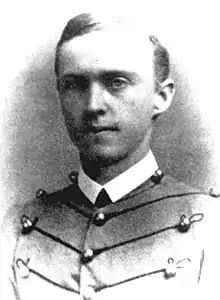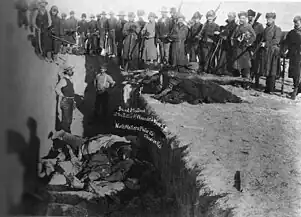John Chowning Gresham | |
|---|---|
 Gresham as a West Point cadet | |
| Born | September 25, 1851 Lancaster County, Virginia |
| Died | September 2, 1926 (aged 74) San Diego, California |
| Place of Burial | |
| Allegiance | United States of America |
| Service/ | United States Army California National Guard |
| Years of service | 1876–1915 (Army) 1915–1918 (National Guard) |
| Rank | Colonel |
| Unit | 7th Cavalry Regiment |
| Commands held | 10th Cavalry Regiment |
| Battles/wars | Indian Wars Philippine–American War |
| Awards | Medal of Honor |
John Chowning Gresham (September 25, 1851 – September 2, 1926) was an officer in the United States Army who was a recipient of the Medal of Honor for his actions during the Wounded Knee Massacre as part of the Indian Wars.
After graduating from the military academy he accepted a commission in the United States Army and saw combat in several battles during the American Indian wars including the Battle of Canyon Creek. He was assigned to the Department of Dakota until 1884 when he was assigned to the Virginia Agricultural College as a professor of Military Science and Tactics.
In 1887 he returned to the campaigns against the Indians where he was injured and received his Medal of Honor for his actions during the Wounded Knee Massacre.
After retiring in 1915 he was recalled to active duty to command the ROTC and SATC programs at the University of Denver as a member of the California National Guard until the programs were disbanded in 1918. He died in San Diego, California in 1926 and is buried in San Francisco National Cemetery.
Life and career
Gresham was born September 25, 1851, in Lancaster County, Virginia, and graduated from the United States Military Academy in 1876. He was commissioned a second lieutenant in the 3rd Cavalry at Fort Lincoln. He transferred to the 7th Cavalry as a replacement following the Battle of Little Big Horn, and served in the Nez Perce War, including the Battle of Canyon Creek. He was promoted to first lieutenant in June 1878, and continued to serve at various posts within the Department of Dakota until September 1884. From September 1884 to February 1887 he was Professor of Military Science and Tactics at Virginia Agricultural College.[1]
In 1887 Gresham returned to duty with the 7th Cavalry and participated in the campaign against the Sioux in the Wounded Knee Massacre, leading a party into a ravine to attack a group of Indians hiding there. For this action he received the Medal of Honor in March 1895.
He was promoted to captain in April 1892 and moved with the regiment to Arizona. He served as Professor of Military Science and Tactics at the North Carolina College of Agriculture and Mechanical Arts from December 1896 until rejoining the regiment in Havana in March 1899.[2]
Gresham was promoted to major of the 6th Cavalry in September 1901, and in January 1902 he sailed for Manila to join the regiment. He served with the 6th Cavalry in the Philippines until August 1903, including General J. Franklin Bell's campaign against Miguel Malvar. He transferred to the 15th Cavalry and returned to the United States. He returned to the Philippines with the 15th Cavalry in October 1905, serving there until July 1906. He transferred to the 9th Cavalry and again returned to the U. S. In July 1907 he was promoted to lieutenant colonel of the 14th Cavalry and given command of the regiment and the post of Boise Barracks. The regiment was sent to Fort Stotsenburg in the Philippines in March 1910.[3]
Gresham was promoted to colonel in August 1911, and, in April 1912 took command of the 10th Cavalry at Fort Ethan Allen, Vermont. In December 1913 he took command of Fort Huachuca, Arizona. He was in charge of militia affairs for the Western Department from August 1914 until he retired in September 1915. However, he was immediately assigned to active duty with the California National Guard in Los Angeles, and beginning in January 1918, he commanded the ROTC and SATC programs at the University of Denver, until they were disbanded in December 1918.
He was a member of the Sons of the American Revolution.
Colonel Gresham died September 2, 1926, in San Diego, California, and is buried in San Francisco National Cemetery.[4][5]
Medal of Honor citation
Rank and organization: First Lieutenant, 7th U.S. Cavalry. Place and date: Wounded Knee Creek, S. Dak., 29 December 1890. Entered service at: Lancaster Courthouse, Va.. Birth: Virginia. Date of issue: 26 March 1895.
Citation:
Voluntarily led a party into a ravine to dislodge Sioux Indians concealed therein. He was wounded during this action.[6]
Controversy

There have been several attempts by various parties to rescind the Medals of Honor awarded in connection with the Battle of Wounded Knee.[7][8][9] Proponents claim that the engagement was in-fact a massacre and not a battle, due to the high number of killed and wounded Lakota women and children and the very one-sided casualty counts. Estimates of the Lakota losses indicate 150–300 killed, of which up to 200 were women and children. Additionally, as many as 51 were wounded. In contrast, the 7th Cavalry suffered 25 killed and 39 wounded, many being the result of friendly fire.[10][11][12]
Calvin Spotted Elk, direct descendant of Chief Spotted Elk killed at Wounded Knee, launched a petition to rescind medals from the soldiers who participated in the battle.[13]
The Army has also been criticized more generally for the seemingly disproportionate number of Medals of Honor awarded in connection with the battle.[14] For comparison, 20 Medals were awarded at Wounded Knee, 21 at the Battle of Cedar Creek, and 20 at the Battle of Antietam.[14][15] Respectively, Cedar Creek and Antietam involved 52,712 and 113,000 troops, suffering 8,674 and 22,717 casualties.[16][17][18][19][20] Wounded Knee, however, involved 610 combatants and resulted in as many as 705 casualties (including non-combatants).[21][10]
See also
References
 This article incorporates public domain material from websites or documents of the United States Army Center of Military History.
This article incorporates public domain material from websites or documents of the United States Army Center of Military History.
- ↑ Cullum, George W. (1891). Biographical Register of the Officers and Graduates of the U. S. Military Academy, Volume III. New York City: Houghton, Mifflin and Company. p. 265.
- ↑ Cullum, George W. (1901). Biographical Register of the Officers and Graduates of the U. S. Military Academy, Volume IV. Cambridge, Massachusetts: Riverside Press. p. 271.
- ↑ Cullum, George W. (1910). Biographical Register of the Officers and Graduates of the U. S. Military Academy, Volume V. Saginaw, Michigan: Seeman & Peters. p. 247.
- ↑ Cullum, George W. (1920). Biographical Register of the Officers and Graduates of the U. S. Military Academy, Volume VI. Saginaw, Michigan: Seeman & Peters. p. 218.
- ↑ Cullum, George W. (1930). Biographical Register of the Officers and Graduates of the U. S. Military Academy, Volume VII. Chicago: R. R. Donnelley & Sons. p. 136.
- ↑ "Medal of Honor recipients". Medal of Honor statistics. United States Army Center of Military History. June 8, 2009. Archived from the original on August 9, 2011. Retrieved March 11, 2010.
- ↑ Dana Lone Hill (February 18, 2013). "The Wounded Knee medals of honor should be rescinded". the Guardian. Retrieved March 1, 2015.
- ↑ "No Medals for Massacre: Close the Open Wound of Wounded Knee". The Huffington Post. February 12, 2013. Retrieved March 1, 2015.
- ↑ "Lakota~WOUNDED KNEE: A Campaign to Rescind Medals: story, pictures and information". Footnote.com. Retrieved August 17, 2011.
- 1 2 "Plains Humanities: Wounded Knee Massacre". Retrieved December 9, 2014.
- ↑ "The 110th Anniversary of the Wounded Knee Massacre". perspicuity.net. Retrieved March 1, 2015.
- ↑ "Wagner...Part Two". dickshovel.com. Retrieved March 1, 2015.
- ↑ Joseph Huff-Hannon (February 12, 2013). "No Medals for massacre: Close the Open Wound of Wounded Knee". Huffington Post.
- 1 2 Green, Jerry (1994). "The Medals of Wounded Knee". Nebraska State Historical Society, also available in Nebraska History #75, pp. 200–208. Nebraska State Historical Society History.
- ↑ Owens, Ronald J. (2004) Medal of Honor: Historical facts and figures. Turner Publishing Company
- ↑ Whitehorne, p. 15. The NPS battle summary lists Union strength of 31,945. Cullen, p. 111, states 35,000 Union effectives, including 10,000 cavalry. Salmon, p. 368, and Kennedy, p. 319, state 32,000 Union.
- ↑ Whitehorne, p. 17. The NPS battle summary and Kennedy, p. 319, list Confederate strength of 21,000. Cullen, p. 112, states 18,000 Confederate effectives, including 4,000 cavalry.
- ↑ Wert, p. 246, Eicher, p. 752. Lewis, p. 288, reports Union totals as 5,764 (569 killed, 3,425 wounded, 1,770 missing), Confederates 3,060 (1,860 killed and wounded, 1,200 prisoners). Kennedy, p. 323, reports 5,672 Union, 2,910 Confederate. The NPS battle summary reports 5,665 Union, 2,910 Confederate. Salmon, p. 372, reports Union "almost 5,700", Confederate "almost 3,000."
- ↑ Eicher, p. 363. Sears, p. 173, cites 75,000 Union troops, with an effective strength of 71,500, with 300 guns; on p. 296, he states that the 12,401 Union casualties were 25% of those who went into action and that McClellan committed "barely 50,000 infantry and artillerymen to the contest"; p. 389, he cites Confederate effective strength of "just over 38,000," including A.P. Hill's division, which arrived in the afternoon. Priest, p. 343, cites 87,164 men present in the Army of the Potomac, with 53,632 engaged, and 30,646 engaged in the Army of Northern Virginia. Luvaas and Nelson, p. 302, cite 87,100 Union engaged, 51,800 Confederate. Harsh, Sounding the Shallows, pp. 201–202, analyzes the historiography of the figures, and shows that Ezra A. Carman (a battlefield historian who influenced some of these sources) used "engaged" figures; the 38,000 excludes Pender's and Field's brigades, roughly half the artillery, and forces used to secure objectives behind the line.
- ↑ Sears, pp. 294–96; Cannan, p. 201. Confederate casualties are estimates because reported figures include undifferentiated casualties at South Mountain and Shepherdstown; Sears remarks that "there is no doubt that a good many of the 1,771 men listed as missing were in fact dead, buried uncounted in unmarked graves where they fell." McPherson, p. 129, gives ranges for the Confederate losses: 1,546–2,700 dead, 7,752–9,024 wounded. He states that more than 2,000 of the wounded on both sides died from their wounds. Priest, p. 343, reports 12,882 Union casualties (2,157 killed, 9,716 wounded, 1,009 missing or captured) and 11,530 Confederate (1,754 killed, 8,649 wounded, 1,127 missing or captured). Luvaas and Nelson, p. 302, cite Union casualties of 12,469 (2,010 killed, 9,416 wounded, 1,043 missing or captured) and 10,292 Confederate (1,567 killed, 8,725 wounded for September 14–20, plus approximately 2,000 missing or captured).
- ↑ Brown, p. 178, Brown states that at the army camp, "the Indians were carefully counted." Utley, p. 204, gives 120 men, 230 women and children; there is no indication how many were warriors, old men, or incapacitated sick like Big Foot.
External links
- "John Chowning Gresham". Hall of Valor. Military Times. Retrieved March 11, 2010.
- "John Chowning Gresham". Claim to Fame: Medal of Honor recipients. Find a Grave. Retrieved February 22, 2010.